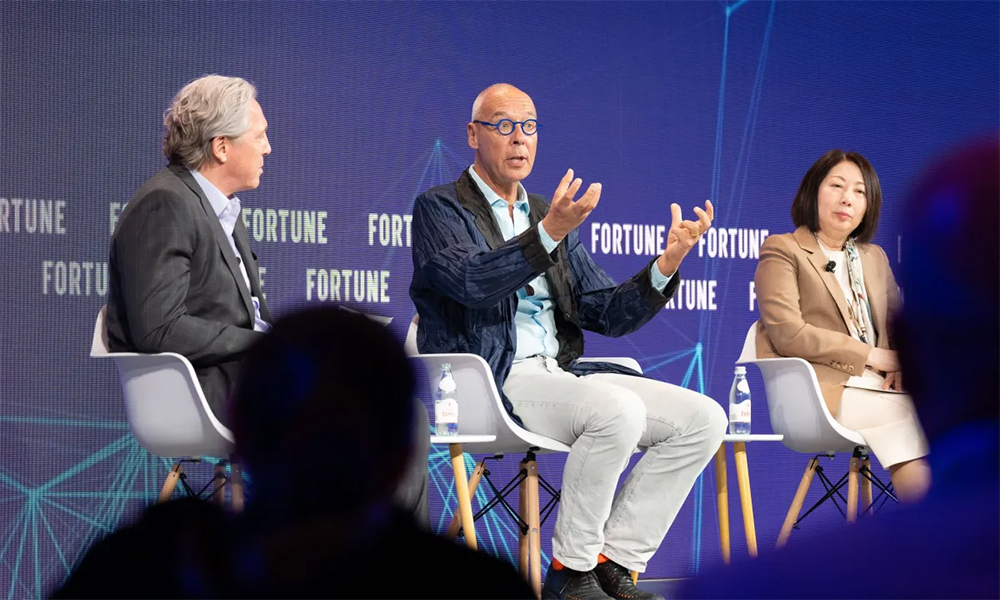
兩周前,日本央行時(shí)隔17年首次把利率上調(diào)至零以上,,從負(fù)0.1%上調(diào)到0至0.1%,,結(jié)束了全球主要經(jīng)濟(jì)體最后的負(fù)利率政策,并向經(jīng)濟(jì)學(xué)家們暗示日本長達(dá)30年的經(jīng)濟(jì)低迷可能終將結(jié)束,。
日本銀行(Bank of Japan)的助理行長清水季子(Tokiko Shimizu)認(rèn)為,,負(fù)利率政策的結(jié)束代表日本經(jīng)濟(jì)迎來了拐點(diǎn),盡管按照國際銀行業(yè)標(biāo)準(zhǔn)來說,,日本加息的幅度微乎其微,。
3月27日,清水季子在中國香港舉辦的《財(cái)富》創(chuàng)新論壇上表示:“加息的幅度很小,,僅上調(diào)了10個(gè)基點(diǎn),。但這對(duì)于日本經(jīng)濟(jì)而言卻是非常重要的一步?!?/p>
這位中央銀行家指出,,日本央行加息這一歷史性舉措,體現(xiàn)出日本國內(nèi)一個(gè)新的現(xiàn)實(shí),,即經(jīng)過多年滯脹之后,,工資和物價(jià)均呈上漲趨勢。
清水季子談到了日本公司與工會(huì)之間最近的工資談判,,她說:“我們之所以決定加息,,是因?yàn)楣べY和物價(jià)之間正在進(jìn)入良性循環(huán),。”談判的結(jié)果是工資提高了5.28%,,為33年來的最大漲薪幅度,。
清水季子稱,其他G7和G20經(jīng)濟(jì)體的央行,,比日本央行更擔(dān)心工資快速上漲,。公司通過漲價(jià)來應(yīng)對(duì)更高的勞動(dòng)成本和日益惡化的通貨膨脹,這反過來會(huì)鼓勵(lì)上班族以后要求進(jìn)一步漲薪,。在20世紀(jì)70年代,,經(jīng)濟(jì)學(xué)家們把西方經(jīng)濟(jì)體的持續(xù)通脹和經(jīng)濟(jì)蕭條歸咎于這種工資-物價(jià)螺旋,并擔(dān)心許多國家可能再次發(fā)生這種情況,。
但日本所面對(duì)的情況截然不同——它數(shù)十年來一直在應(yīng)對(duì)持續(xù)通貨緊縮,,通貨緊縮導(dǎo)致國內(nèi)消費(fèi)低迷、工資上漲停滯和資產(chǎn)價(jià)格下跌,。對(duì)清水季子和她的同事們來說,,今年3月的工資談判表明,日本最終有望看到一種更正常的通脹模式,。
3月27日,,清水季子預(yù)測,日本不太可能進(jìn)一步加息,?!拔覀冾A(yù)測未來幾年的物價(jià)波動(dòng)幅度大約為2%。這意味著我們并不認(rèn)為加息是必要的,?!?/p>
今年2月,日本的整體通脹率提高到2.8%,。這是該數(shù)字連續(xù)23個(gè)月達(dá)到或超過日本央行制定的2%的目標(biāo),。
日本是否將回歸?
日本最近的加息,,只是全球第四大經(jīng)濟(jì)體將重回正軌這一論調(diào)的一部分,。日本的股票市場現(xiàn)在已經(jīng)超過了1989年12月,即日本經(jīng)濟(jì)泡沫達(dá)到頂峰時(shí)創(chuàng)下的紀(jì)錄,。
資深日本觀察者,、沖繩科學(xué)技術(shù)大學(xué)院大學(xué)(Okinawa Institute for Science and Technology)的董事杰斯珀·科爾在3月27日表示,日本可能終于已經(jīng)度過了拐點(diǎn),。
科爾用辭職人數(shù)來證明勞動(dòng)力市場變得更加緊張?!斑^去四五年,,[辭職率]大幅提高,。”他說,?!叭毡镜南乱淮贻p精英們更有冒險(xiǎn)精神?!庇腥种娜毡灸贻p人選擇了創(chuàng)業(yè),。
在高層職位上,也有一些變化,??茽柗Q:“從日本領(lǐng)先上市公司新任命的首席執(zhí)行官們的年齡來看,首席執(zhí)行官的年齡已經(jīng)從69歲下降到57歲,?!?/p>
公司也在恢復(fù)對(duì)日本的投資。今年2月,,領(lǐng)先的芯片制造商臺(tái)積電(Taiwan Semiconductor Manufacturing Company)在日本九州島熊本縣的一家工廠開業(yè),。九州島有時(shí)候被稱為“硅島”。
最后,,科爾表示,,日本正在成為一個(gè)“移民超級(jí)大國”,這個(gè)傳統(tǒng)封閉的國家吸引了越來越多的移民,。
科爾解釋道:“現(xiàn)在有320萬外國人生活在日本,,其中240萬人實(shí)際上是在日本工作。我在20世紀(jì)80年代中期來到日本時(shí),,在日外國人的數(shù)量只有50萬人,。”
人口老齡化
清水季子和科爾都提到了日本經(jīng)濟(jì)面臨的一個(gè)嚴(yán)峻挑戰(zhàn):日益萎縮的勞動(dòng)力,。日本是全球人口老齡化最嚴(yán)重的國家之一,,十多年來,日本政府一直試圖提高生育率,,卻未能成功,。
這意味著日本必須以更少的人口維持增長。清水季子認(rèn)為,,解決這個(gè)問題的答案是借助機(jī)器人,、自動(dòng)化和人工智能等技術(shù)。
她說:“相比西方人,,日本人喜歡機(jī)器人,。”她用著名日本卡通角色哆啦A夢的毛絨玩具,來證明自己的觀點(diǎn),。她解釋道,,機(jī)器人可以幫助鼓勵(lì)更多的日本女性和老年人進(jìn)入勞動(dòng)力市場,壯大國內(nèi)的勞動(dòng)力,。
但科爾認(rèn)為人口結(jié)構(gòu)的變化,,能夠給日本的經(jīng)濟(jì)注入活力。
科爾表示:“日本正處于人口結(jié)構(gòu)的甜蜜點(diǎn),,因?yàn)閲鴥?nèi)四分之一人口已經(jīng)超過70歲,,而且嬰兒潮一代將會(huì)優(yōu)雅地離世?!?/p>
他說:“現(xiàn)在我們有更年輕的一代人,,他們擁有全新的觀念。這些年輕人現(xiàn)在離開了政府部門,,但他們沒有加入三菱(Mitsubishi Corporation)等大公司,,而是選擇了自己創(chuàng)業(yè)?!保ㄘ?cái)富中文網(wǎng))
譯者:劉進(jìn)龍
審校:汪皓
兩周前,,日本央行時(shí)隔17年首次把利率上調(diào)至零以上,從負(fù)0.1%上調(diào)到0至0.1%,,結(jié)束了全球主要經(jīng)濟(jì)體最后的負(fù)利率政策,,并向經(jīng)濟(jì)學(xué)家們暗示日本長達(dá)30年的經(jīng)濟(jì)低迷可能終將結(jié)束。
日本銀行(Bank of Japan)的助理行長清水季子(Tokiko Shimizu)認(rèn)為,,負(fù)利率政策的結(jié)束代表日本經(jīng)濟(jì)迎來了拐點(diǎn),,盡管按照國際銀行業(yè)標(biāo)準(zhǔn)來說,日本加息的幅度微乎其微,。
3月27日,,清水季子在中國香港舉辦的《財(cái)富》創(chuàng)新論壇上表示:“加息的幅度很小,僅上調(diào)了10個(gè)基點(diǎn),。但這對(duì)于日本經(jīng)濟(jì)而言卻是非常重要的一步,。”
這位中央銀行家指出,,日本央行加息這一歷史性舉措,,體現(xiàn)出日本國內(nèi)一個(gè)新的現(xiàn)實(shí),即經(jīng)過多年滯脹之后,,工資和物價(jià)均呈上漲趨勢,。
清水季子談到了日本公司與工會(huì)之間最近的工資談判,她說:“我們之所以決定加息,,是因?yàn)楣べY和物價(jià)之間正在進(jìn)入良性循環(huán),?!闭勁械慕Y(jié)果是工資提高了5.28%,為33年來的最大漲薪幅度,。
清水季子稱,,其他G7和G20經(jīng)濟(jì)體的央行,,比日本央行更擔(dān)心工資快速上漲,。公司通過漲價(jià)來應(yīng)對(duì)更高的勞動(dòng)成本和日益惡化的通貨膨脹,這反過來會(huì)鼓勵(lì)上班族以后要求進(jìn)一步漲薪,。在20世紀(jì)70年代,,經(jīng)濟(jì)學(xué)家們把西方經(jīng)濟(jì)體的持續(xù)通脹和經(jīng)濟(jì)蕭條歸咎于這種工資-物價(jià)螺旋,并擔(dān)心許多國家可能再次發(fā)生這種情況,。
但日本所面對(duì)的情況截然不同——它數(shù)十年來一直在應(yīng)對(duì)持續(xù)通貨緊縮,,通貨緊縮導(dǎo)致國內(nèi)消費(fèi)低迷、工資上漲停滯和資產(chǎn)價(jià)格下跌,。對(duì)清水季子和她的同事們來說,,今年3月的工資談判表明,日本最終有望看到一種更正常的通脹模式,。
3月27日,,清水季子預(yù)測,日本不太可能進(jìn)一步加息,?!拔覀冾A(yù)測未來幾年的物價(jià)波動(dòng)幅度大約為2%。這意味著我們并不認(rèn)為加息是必要的,?!?/p>
今年2月,日本的整體通脹率提高到2.8%,。這是該數(shù)字連續(xù)23個(gè)月達(dá)到或超過日本央行制定的2%的目標(biāo),。
日本是否將回歸?
日本最近的加息,,只是全球第四大經(jīng)濟(jì)體將重回正軌這一論調(diào)的一部分,。日本的股票市場現(xiàn)在已經(jīng)超過了1989年12月,即日本經(jīng)濟(jì)泡沫達(dá)到頂峰時(shí)創(chuàng)下的紀(jì)錄,。
資深日本觀察者,、沖繩科學(xué)技術(shù)大學(xué)院大學(xué)(Okinawa Institute for Science and Technology)的董事杰斯珀·科爾在3月27日表示,日本可能終于已經(jīng)度過了拐點(diǎn),。
科爾用辭職人數(shù)來證明勞動(dòng)力市場變得更加緊張,。“過去四五年,,[辭職率]大幅提高,。”他說?!叭毡镜南乱淮贻p精英們更有冒險(xiǎn)精神,。”有三分之二的日本年輕人選擇了創(chuàng)業(yè),。
在高層職位上,,也有一些變化??茽柗Q:“從日本領(lǐng)先上市公司新任命的首席執(zhí)行官們的年齡來看,,首席執(zhí)行官的年齡已經(jīng)從69歲下降到57歲?!?/p>
公司也在恢復(fù)對(duì)日本的投資,。今年2月,領(lǐng)先的芯片制造商臺(tái)積電(Taiwan Semiconductor Manufacturing Company)在日本九州島熊本縣的一家工廠開業(yè),。九州島有時(shí)候被稱為“硅島”,。
最后,科爾表示,,日本正在成為一個(gè)“移民超級(jí)大國”,,這個(gè)傳統(tǒng)封閉的國家吸引了越來越多的移民。
科爾解釋道:“現(xiàn)在有320萬外國人生活在日本,,其中240萬人實(shí)際上是在日本工作,。我在20世紀(jì)80年代中期來到日本時(shí),在日外國人的數(shù)量只有50萬人,?!?/p>
人口老齡化
清水季子和科爾都提到了日本經(jīng)濟(jì)面臨的一個(gè)嚴(yán)峻挑戰(zhàn):日益萎縮的勞動(dòng)力。日本是全球人口老齡化最嚴(yán)重的國家之一,,十多年來,,日本政府一直試圖提高生育率,卻未能成功,。
這意味著日本必須以更少的人口維持增長,。清水季子認(rèn)為,解決這個(gè)問題的答案是借助機(jī)器人,、自動(dòng)化和人工智能等技術(shù),。
她說:“相比西方人,日本人喜歡機(jī)器人,?!彼弥毡究ㄍń巧呃睞夢的毛絨玩具,來證明自己的觀點(diǎn),。她解釋道,,機(jī)器人可以幫助鼓勵(lì)更多的日本女性和老年人進(jìn)入勞動(dòng)力市場,,壯大國內(nèi)的勞動(dòng)力。
但科爾認(rèn)為人口結(jié)構(gòu)的變化,,能夠給日本的經(jīng)濟(jì)注入活力,。
科爾表示:“日本正處于人口結(jié)構(gòu)的甜蜜點(diǎn),因?yàn)閲鴥?nèi)四分之一人口已經(jīng)超過70歲,,而且嬰兒潮一代將會(huì)優(yōu)雅地離世,。”
他說:“現(xiàn)在我們有更年輕的一代人,,他們擁有全新的觀念,。這些年輕人現(xiàn)在離開了政府部門,但他們沒有加入三菱(Mitsubishi Corporation)等大公司,,而是選擇了自己創(chuàng)業(yè)?!保ㄘ?cái)富中文網(wǎng))
譯者:劉進(jìn)龍
審校:汪皓
Japan’s central bank raised interest rates above zero for the first time in 17 years just under two weeks ago. It lifted interest rates to 0-0.1%, up from -0.1%, ending the world’s last negative interest rate regime among major economies—and signaling to economists that Japan’s 30-year slump may finally be over.
Tokiko Shimizu, an assistant governor at the Bank of Japan, is one of those who sees the ending of the negative rate regime as symbolic of Japan turning a corner—even if the rate increase is tiny by international banking standards.
“The step itself is very small—10 basis points,” she said on March 27 at the Fortune Innovation Forum in Hong Kong. “But it’s a very great step for the Japanese economy.”
For the central banker, this historic step by the Japanese central bank reflects a new reality in the country, where wages and prices are rising after years of stagnation.
“The reason we decided to change it is because the virtuous cycle between wages and price is going on,” she said, pointing to recent wage negotiations between Japanese companies and labor unions. Discussions led to a 5.28% pay increase, the largest raise in 33 years.
Shimizu noted that her colleagues in other G7 and G20 economies are more worried than Japan’s central bank is about fast wage growth. Companies raise prices to account for higher labor costs, worsening inflation, and, in turn, encouraging workers to ask for more pay increases later. Economists blamed this wage-price spiral for persistent inflation and economic stagnation in Western economies in the 1970s, and worries about this happening again persist in many countries.
Yet Japan has instead faced an altogether different fight—it has battled persistent deflation for decades, causing lower consumption, stagnant wages and falling asset prices. For Shimizu and her colleagues, March’s wage negotiations show that Japan might finally be seeing a more normal pattern of inflation.
On March 27, Shimizu forecast that further interest rate increases were unlikely. “We expect the price movement in coming years to be around 2%. That means we don’t see any interest rate hike [to be] necessary.”
Headline inflation accelerated to 2.8% in February. It marked the 23rd consecutive month the figure has met or surpassed the central bank’s 2% price target.
Is Japan back?
Japan’s recent interest rate hike is just part of a larger narrative that the world’s fourth-largest economy is back on track. The country’s stock markets have now surpassed records set all the way back in December 1989, at the peak of Japan’s bubble economy.
Jesper Koll, board director at the Okinawa Institute for Science and Technology and a veteran Japan watcher, said on March 27 the country may have finally turned a corner.
Koll pointed to the number of people quitting their jobs as an indication of a tighter labor market. “Over the past four or five years, this [quit rate] has shot up very dramatically,” Koll said. “The elite, the young, the next generation of Japan are now taking risks,” he continued, with two-thirds of young Japanese now going to start-ups.
There are changes at the top too. “When you look at the age of the new CEOs that have been appointed by the leading companies in Japan by listed companies, the age of the CEO has dropped from 69 to 57,” Koll said.
Companies are also re-investing in Japan. Leading chipmaker Taiwan Semiconductor Manufacturing Company just opened a factory in Kumamoto prefecture on the island of Kyushu—sometimes called “Silicon Island”—in February.
Finally, Koll suggested that Japan was becoming an “immigration superpower,” with the traditionally-closed country attracting many more migrants.
“Now there are 3.2 million non-Japanese living in Japan, of which 2.4 million are actually working. When I showed up in Japan in the mid-1980s, there were barely 500,000,” Koll explained.
Aging population
Both Shimizu and Koll mentioned one significant challenge for the Japanese economy: Its shrinking workforce. Japan has one of the world’s oldest populations, and the country’s government has tried, and failed, to lift fertility rates for over a decade.
That means Japan will have to sustain growth with fewer people. For Shimizu, the answer to the problem comes through robots, automation and AI.
“Japanese people love robots, compared to Western people,” she said, using a stuffed toy of Doraemon, the famous Japanese cartoon robot cat, to reinforce her point. Robots can help Japan encourage more women and elderly to join the labor market, expanding the country’s workforce, she explained.
Koll, instead, sees demographic change as a way to reinvigorate Japan’s economy.
“Japan is in this demographic sweet spot because one in four is already over 70-years-old and the baby boomer generation is going to have to die gracefully,” Koll said.
“Now we’ve got a clean slate for the younger generation,” he said. “This young generation is now leaving the Ministry of Finance…not going to Mitsubishi Corporation, but setting up a new company.”






